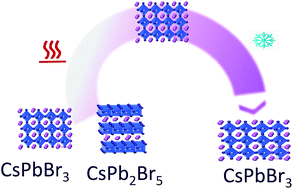Cell refinement of CsPbBr3 perovskite nanoparticles and thin films
Abstract
In this work, we performed a detailed study of the phase transformations and structural unit cell parameters of CsPbBr3 nanoparticles (NPs) and thin films. In situ X-ray diffraction patterns were acquired as a function of temperature, where the positions and widths of the diffraction peaks were systematically tracked upon heating and cooling down to room temperature (RT). Scanning electron microscopy provides physical insight on the CsPbBr3 thin films upon annealing and transmission electron microscopy gives physical and crystallographic information for the CsPbBr3 NPs using electron diffraction. The secondary phase(s) CsPb2Br5 (and CsPb4Br6) are clearly observed in the XRD patterns of both nanoparticles and thin films upon heating to 500 K, whilst from 500 K to 595 K, these phases remain in small amounts and are kept like this upon cooling down to RT. However, in the case of thin films, the CsPb2Br5 secondary phase disappears completely above 580 K and pure cubic CsPbBr3 is observed up to 623 K. The CsPbBr3 phase is then kept upon cooling down to RT, achieving pure CsPbBr3 phase. This study provides detailed understanding of the phase behavior vs. temperature of CsPbBr3 NPs and thin films, which opens the way to pure CsPbBr3 phase, an interesting material for optoelectronic applications.

- This article is part of the themed collections: Nanoscale Advances Most Popular Articles so far and International Year of the Periodic Table : From Pb and Sn Perovskites to the Next Generation


 Please wait while we load your content...
Please wait while we load your content...